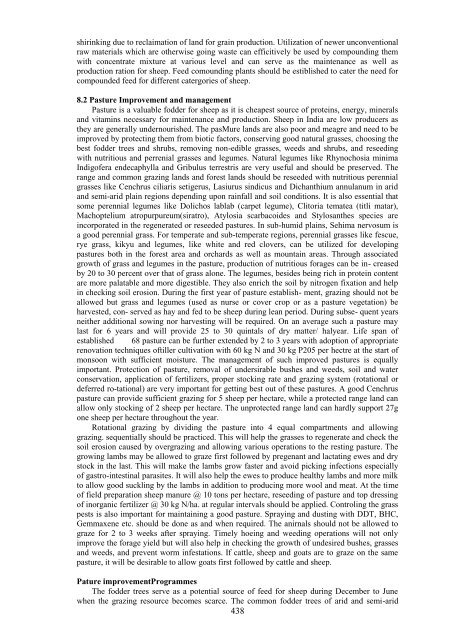Create successful ePaper yourself
Turn your PDF publications into a flip-book with our unique Google optimized e-Paper software.
shirinking due to reclaimation of land for grain production. Utilization of newer unconventional<br />
raw materials which are otherwise going waste can efficitively be used by compounding them<br />
with concentrate mixture at various level and can serve as the maintenance as well as<br />
production ration for sheep. Feed comounding plants should be estiblished to cater the need for<br />
compounded feed for different catergories of sheep.<br />
8.2 Pasture Improvement and management<br />
Pasture is a valuable fodder for sheep as it is cheapest source of proteins, energy, minerals<br />
and vitamins necessary for maintenance and production. <strong>Sheep</strong> in India are low producers as<br />
they are generally undernourished. The pasMure lands are also poor and meagre and need to be<br />
improved by protecting them from biotic factors, conserving good natural grasses, choosing the<br />
best fodder trees and shrubs, removing non-edible grasses, weeds and shrubs, and reseeding<br />
with nutritious and perrenial grasses and legumes. Natural legumes like Rhynochosia minima<br />
Indigofera endecaphylla and Gribulus terrestris are very useful and should be preserved. The<br />
range and common grazing lands and forest lands should be reseeded with nutritious perennial<br />
grasses like Cenchrus ciliaris setigerus, Lasiurus sindicus and Dichanthium annulanum in arid<br />
and semi-arid plain regions depending upon rainfall and soil conditions. It is also essential that<br />
some perennial legumes like Dolichos lablab (carpet legume), Clitoria tematea (titli matar),<br />
Machoptelium atropurpureum(siratro), Atylosia scarbacoides and Stylosanthes species are<br />
incorporated in the regenerated or reseeded pastures. In sub-humid plains, Sehima nervosum is<br />
a good perennial grass. For temperate and sub-temperate regions, perennial grasses like fescue,<br />
rye grass, kikyu and legumes, like white and red clovers, can be utilized for developing<br />
pastures both in the forest area and orchards as well as mountain areas. Through associated<br />
growth of grass and legumes in the pasture, production of nutritious forages can be in- creased<br />
by 20 to 30 percent over that of grass alone. The legumes, besides being rich in protein content<br />
are more palatable and more digestible. They also enrich the soil by nitrogen fixation and help<br />
in checking soil erosion. During the first year of pasture establish- ment, grazing should not be<br />
allowed but grass and legumes (used as nurse or cover crop or as a pasture vegetation) be<br />
harvested, con- served as hay and fed to be sheep during lean period. During subse- quent years<br />
neither additional sowing nor harvesting will be required. On an average such a pasture may<br />
last for 6 years and will provide 25 to 30 quintals of dry matter/ halyear. Life span of<br />
established 68 pasture can be further extended by 2 to 3 years with adoption of appropriate<br />
renovation techniques oftiller cultivation with 60 kg N and 30 kg P205 per hectre at the start of<br />
monsoon with sufficient moisture. The management of such improved pastures is equally<br />
important. Protection of pasture, removal of undersirable bushes and weeds, soil and water<br />
conservation, application of fertilizers, proper stocking rate and grazing system (rotational or<br />
deferred ro-tational) are very important for getting best out of these pastures. A good Cenchrus<br />
pasture can provide sufficient grazing for 5 sheep per hectare, while a protected range land can<br />
allow only stocking of 2 sheep per hectare. The unprotected range land can hardly support 27g<br />
one sheep per hectare throughout the year.<br />
Rotational grazing by dividing the pasture into 4 equal compartments and allowing<br />
grazing. sequentially should be practiced. This will help the grasses to regenerate and check the<br />
soil erosion caused by overgrazing and allowing various operations to the resting pasture. The<br />
growing lambs may be allowed to graze first followed by pregenant and lactating ewes and dry<br />
stock in the last. This will make the lambs grow faster and avoid picking infections especially<br />
of gastro-intestinal parasites. It will also help the ewes to produce healthy lambs and more milk<br />
to allow good suckling by the lambs in addition to producing more wool and meat. At the time<br />
of field preparation sheep manure @ 10 tons per hectare, reseeding of pasture and top dressing<br />
of inorganic fertilizer @ 30 kg N/ha. at regular intervals should be applied. Controling the grass<br />
pests is also important for maintaining a good pasture. Spraying and dusting with DDT, BHC,<br />
Gemmaxene etc. should be done as and when required. The anirnals should not be allowed to<br />
graze for 2 to 3 weeks after spraying. Timely hoeing and weeding operations will not only<br />
improve the forage yield but will also help in checking the growth of undesired bushes, grasses<br />
and weeds, and prevent worm infestations. If cattle, sheep and goats are to graze on the same<br />
pasture, it will be desirable to allow goats first followed by cattle and sheep.<br />
Pature improvementProgrammes<br />
The fodder trees serve as a potential source of feed for sheep during December to June<br />
when the grazing resource becomes scarce. The common fodder trees of arid and semi-arid<br />
438




